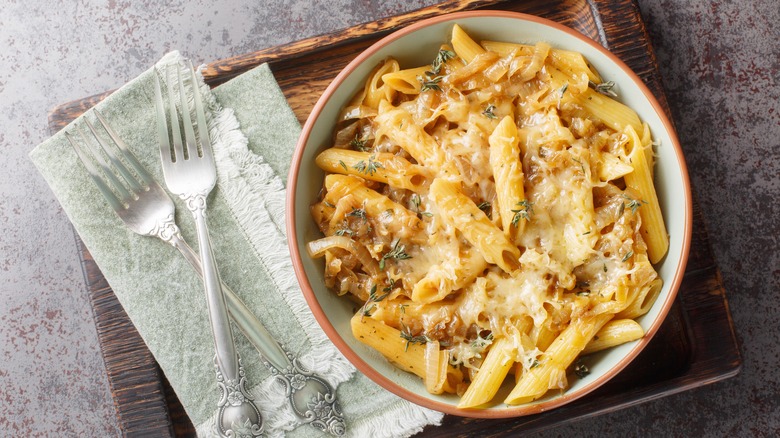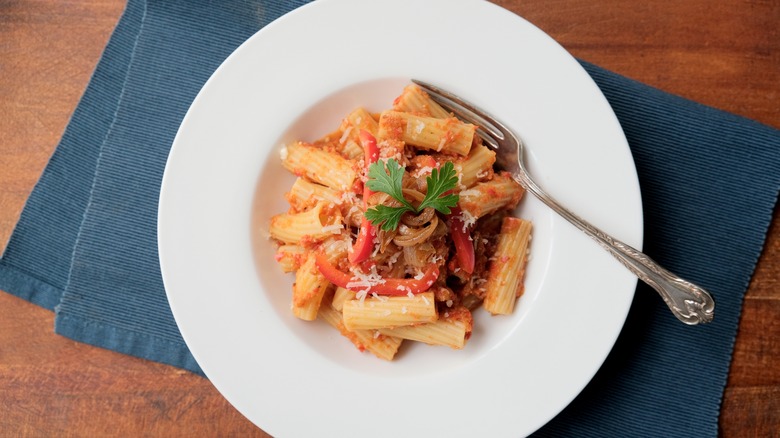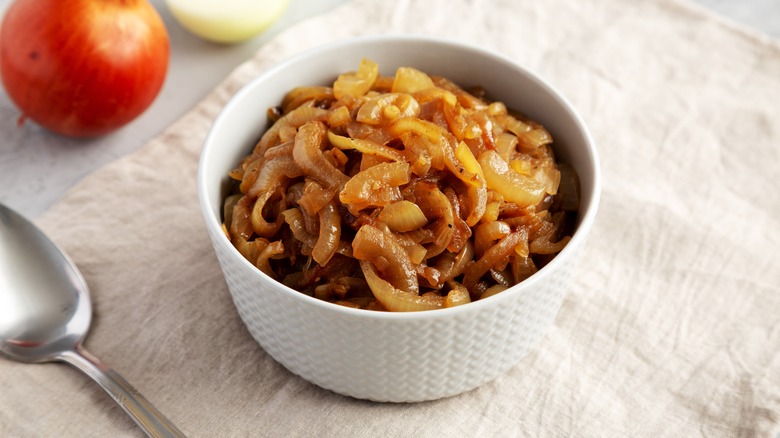Caramelized Onions Belong In Your Next Pasta Dish
When it comes to pasta, garlic might be allium that immediately comes to mind. And that would be a logical connection, considering that many delicious sauces feature these cloves, from zesty marinara to creamy vodka sauce to herbaceous basil pesto, and beyond. But garlic's close cousin, the onion, has a place in your pasta, too — especially in its caramelized form.
Onions are high on the list of sweetest vegetables, with 4.2 grams of sugar per 100 grams. That means that once sliced up and cooked down with a fat (butter or oil both work), all those natural sugars concentrate and — as the name suggests — caramelize into a tender, irresistibly aromatic, sweet and savory ingredient that can add depth, richness, and complexity to everything from soups to dips.
So what makes caramelized onions so perfect for pasta? Noodles are an ideal platform for bold flavors like caramelized onions; pasta won't compete with that signature savory taste, but it can also stand up to it. Additionally, caramelized onions can complement and contrast so many ingredients commonly found in pasta recipes, from robust meats to salty cheeses, veggies like mushrooms and eggplants, balsamic vinegar to tangy tomato sauce.
Caramelized perfection in your pasta
The process of caramelization is transformative, converting an assertive and pungent flavor into a sweet, craveable, and more approachable new ingredient that will be at home in a variety of pasta preparations. TikTok's viral French Onion Pasta mimics the brothy, unctuous soup but changes the game by combining those beloved flavors with toothsome carbs for a more sustaining meal. And because caramelized onions are such flavorful umami bombs, you can easily achieve a satisfying savoriness in vegetarian or vegan pastas without the need for meat.
Incorporating your onions will vary a bit depending on your recipe. In some cases, like this simple yogurt-based chicken and caramelized onion pasta, you may begin by caramelizing slices of onion in olive oil, then building layers of flavor by adding your chicken. This way, you infuse all that sweet and savory goodness into every bite before tossing with your pasta and finishing the dish with creamy dairy. A caramelized onion bolognese might leverage a similar approach, first caramelizing onions and then introducing ingredients like carrots, celery and garlic, before combining with your sautéed meat, followed by a simmer in tomatoes and herbs to finish the sauce. In other cases, however, you may simply stir in a handful of ready-made caramelized onions into your sauce, and toss with your pasta.
Making and stashing your onions
Caramelizing your onions is super simple, although it takes a little time. On the stovetop, you can get the job done in around 15 to 20 minutes, while the oven might take a little closer to 40 or 50 minutes (you'll need to stir frequently on the stove, and only about every 10 minutes in the oven). You can keep the ingredient list at its most basic, with nothing more than onions, a fat, and some salt. You can also elaborate with additional elements, from stocks to wines like sherry, to vinegars for a balancing tang (balsamic or red wine work well), or even honey for extra sweetness.
Additionally, you can make a big batch of caramelized onions and stash some in an airtight container for about a week (or even freeze them in an ice cube tray). This way you have plenty on hand for a last minute meal loaded with flavor — which is a handy make-ahead trick for entertaining, too. And since the rich, complex qualities of caramelized onions have such broad appeal that even the onion-averse can often find a way to enjoy them, you might find yourself working them into a pasta every chance you get.


